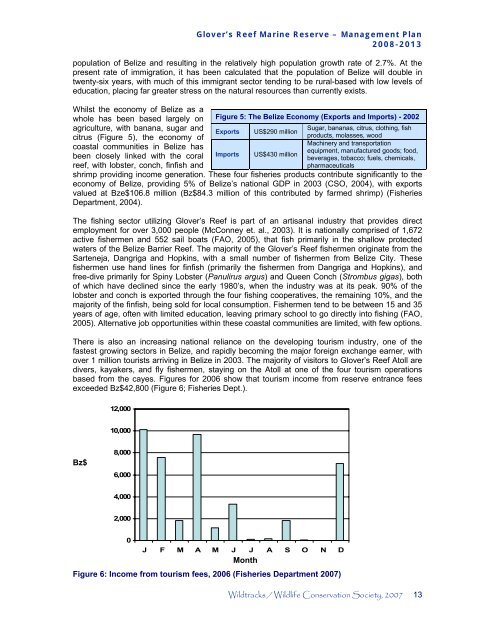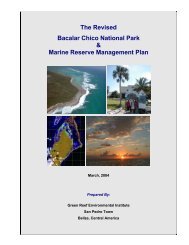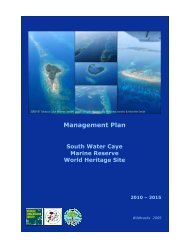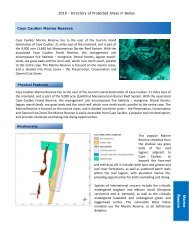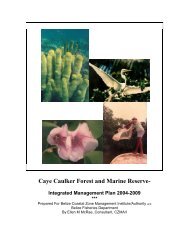Management Plan - Glover's Reef Marine Reserve
Management Plan - Glover's Reef Marine Reserve
Management Plan - Glover's Reef Marine Reserve
Create successful ePaper yourself
Turn your PDF publications into a flip-book with our unique Google optimized e-Paper software.
Glover’s <strong>Reef</strong> <strong>Marine</strong> <strong>Reserve</strong> – <strong>Management</strong> <strong>Plan</strong><br />
2008-2013<br />
population of Belize and resulting in the relatively high population growth rate of 2.7%. At the<br />
present rate of immigration, it has been calculated that the population of Belize will double in<br />
twenty-six years, with much of this immigrant sector tending to be rural-based with low levels of<br />
education, placing far greater stress on the natural resources than currently exists.<br />
Whilst the economy of Belize as a<br />
whole has been based largely on<br />
agriculture, with banana, sugar and<br />
citrus (Figure 5), the economy of<br />
coastal communities in Belize has<br />
been closely linked with the coral<br />
reef, with lobster, conch, finfish and<br />
shrimp providing income generation. These four fisheries products contribute significantly to the<br />
economy of Belize, providing 5% of Belize’s national GDP in 2003 (CSO, 2004), with exports<br />
valued at Bze$106.8 million (Bz$84.3 million of this contributed by farmed shrimp) (Fisheries<br />
Department, 2004).<br />
The fishing sector utilizing Glover’s <strong>Reef</strong> is part of an artisanal industry that provides direct<br />
employment for over 3,000 people (McConney et. al., 2003). It is nationally comprised of 1,672<br />
active fishermen and 552 sail boats (FAO, 2005), that fish primarily in the shallow protected<br />
waters of the Belize Barrier <strong>Reef</strong>. The majority of the Glover’s <strong>Reef</strong> fishermen originate from the<br />
Sarteneja, Dangriga and Hopkins, with a small number of fishermen from Belize City. These<br />
fishermen use hand lines for finfish (primarily the fishermen from Dangriga and Hopkins), and<br />
free-dive primarily for Spiny Lobster (Panulirus argus) and Queen Conch (Strombus gigas), both<br />
of which have declined since the early 1980’s, when the industry was at its peak. 90% of the<br />
lobster and conch is exported through the four fishing cooperatives, the remaining 10%, and the<br />
majority of the finfish, being sold for local consumption. Fishermen tend to be between 15 and 35<br />
years of age, often with limited education, leaving primary school to go directly into fishing (FAO,<br />
2005). Alternative job opportunities within these coastal communities are limited, with few options.<br />
There is also an increasing national reliance on the developing tourism industry, one of the<br />
fastest growing sectors in Belize, and rapidly becoming the major foreign exchange earner, with<br />
over 1 million tourists arriving in Belize in 2003. The majority of visitors to Glover’s <strong>Reef</strong> Atoll are<br />
divers, kayakers, and fly fishermen, staying on the Atoll at one of the four tourism operations<br />
based from the cayes. Figures for 2006 show that tourism income from reserve entrance fees<br />
exceeded Bz$42,800 (Figure 6; Fisheries Dept.).<br />
Bz$<br />
12,000<br />
10,000<br />
8,000<br />
6,000<br />
4,000<br />
2,000<br />
0<br />
Figure 5: The Belize Economy (Exports and Imports) - 2002<br />
Exports US$290 million<br />
Imports US$430 million<br />
J F M A M J J A S O N D<br />
Month<br />
Figure 6: Income from tourism fees, 2006 (Fisheries Department 2007)<br />
Sugar, bananas, citrus, clothing, fish<br />
products, molasses, wood<br />
Machinery and transportation<br />
equipment, manufactured goods; food,<br />
beverages, tobacco; fuels, chemicals,<br />
pharmaceuticals<br />
Wildtracks / Wildlife Conservation Society, 2007 13


